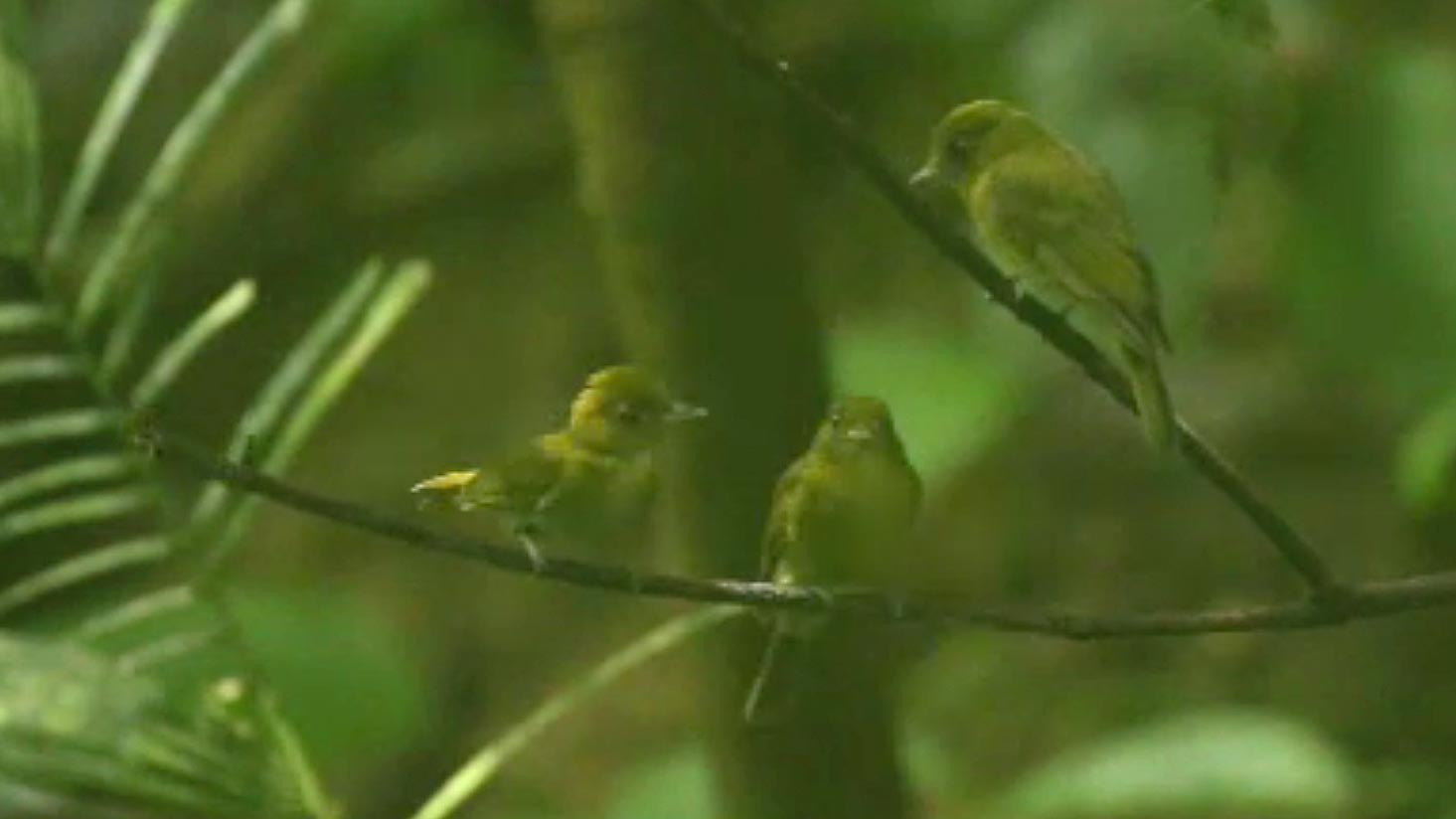Field Study Helps Confirm the Sapayoa Is Like No Other Bird in the New World
April 27, 2016
The most enigmatic bird in Central America doesn’t look all that strange at first glance. It’s a small, olive-yellow creature that perches upright and catches insects for a living. It looks rather like a flycatcher, or perhaps some longer-tailed, broader-billed variety of manakin. But although the Sapayoa—whose scientific name actually contains the word aenigma—has at times been classified as a flycatcher or manakin, it’s neither. In fact, its closest relatives are not to be found anywhere in the Americas at all. They all live in Africa and Asia, composing a group of just over 50 species known as the Old World suboscines.
This surprising piece of biogeography—one species separated from its ancestry by an entire ocean—had already been suggested by genetic data, but supporting behavioral data was virtually nonexistent. Now, a new field study conducted by Cornell University students and alumni has finally uncovered details of this secretive species’ breeding biology. It shows clear links to the bird’s Old World relatives and further distances it from New World suboscines.
The research team included Cornell undergraduates Sarah Dzielski and Benjamin Van Doren, along with Cornell alumni Jack Hruska and Justin Hite. The paper went online this week in The Auk: Ornithological Advances and is slated to appear on the cover of the print journal this summer.
The team studied Sapayoas in the remote Darién region of eastern Panama near the Colombian border. Working from a field camp they found two active nests and 13 old nests. The nests were pear-shaped structures hanging from vegetation over steep, rocky ravines, similar to the only previously known nest (described in 2001 by another Cornell alumnus, Daniel Christian).
Monitoring the active nests yielded the biggest surprise of the project: that Sapayoas are cooperative breeders. At one nest, two immature male birds assisted an adult male and adult female in feeding the young. The researchers were also surprised by the social behavior they observed, which included mounting between individuals of the same sex, possibly to establish dominance and maintain social cohesion.
Dzielski later summarized the distinctive new behaviors this way:
The team soon learned that all four birds brought food to the two chicks inside the hanging nest, indicating that Sapayoas are cooperative breeders. The four attending birds also engaged in a number of odd behaviors. The male birds mounted the female (as if trying to copulate) multiple times a day, even though their nest already held two fast-growing chicks. The males also mounted one another on different occasions, involving both the adult male mounting a younger male and one younger male mounting the other. This type of same-sex mounting is unusual in birds, but when it occurs it is often associated with social dominance.
Oddly, the younger males in the group occasionally arrived at the nest with food but left without feeding the young—sometimes even eating the food themselves. This could represent “fake-feeding,” when birds bring food to the nest to appear like team players, but sneakily eat it themselves. It’s also possible that the young males were simply balancing the needs of the chicks with their own hunger. Clearly, there is much still to learn.
The new paper compiles these extended observations of Sapayoa breeding behavior, and the authors provide hints at how this unusual bird is connected with its roots. Many of the Sapayoa’s Old World relatives are cooperative breeders, getting help from family groups, and the pear-shaped hanging nest also is consistent with Old World suboscines. These traits are rare among the New World suboscines.
In all, the team spent a month in the field searching for and monitoring Sapayoa nests, and they observed the family group at their focal nest for more than 70 hours over 10 days. “Nest searching was always an adventure,” Dzielski said. “We found countless abandoned nests, and while checking inside for eggs or evidence that the nest was active, we found all sorts of surprises. In a few instances, a large grasshopper the size of a mouse hopped out from under the flap and scared the daylights out of us!”
“The Sapayoa is so different from other passerine birds that it is currently placed in its own family, Sapayoidae, but relatively little is known about its natural history,” Van Doren added. “This gap in scientific knowledge was the reason we traveled to eastern Panama to learn about this enigmatic species. We hoped that more information about the Sapayoa’s natural history would cast its surprising evolutionary relationships in a new and clearer light.”
“The Sapayoa has long been a mystery bird. When my colleagues and I identified it as the only Old World suboscine in the New World in 2003, it only became more mysterious,” said Jon Fjeldså of the University of Copenhagen, who led the research team that first identified the Sapayoa’s unusual origins. “How did it arrive in South America? Why does it resemble a manakin? And does it still behave like an Old World suboscine? I am excited to learn that it indeed does!”
The field expedition was funded in part by the Ivy Expeditions Fund at the Cornell Lab of Ornithology. This article includes reporting and writing provided by the Central Ornithology Publication Office.

All About Birds
is a free resource
Available for everyone,
funded by donors like you
American Kestrel by Blair Dudeck / Macaulay Library
